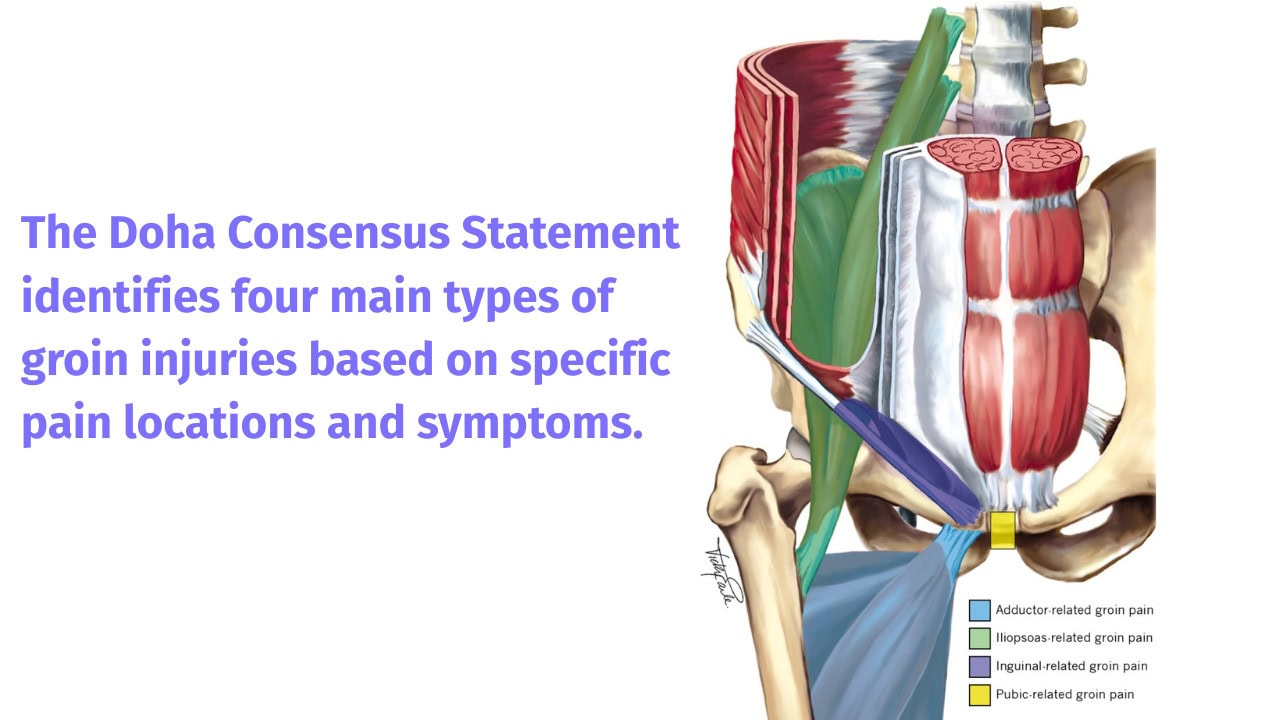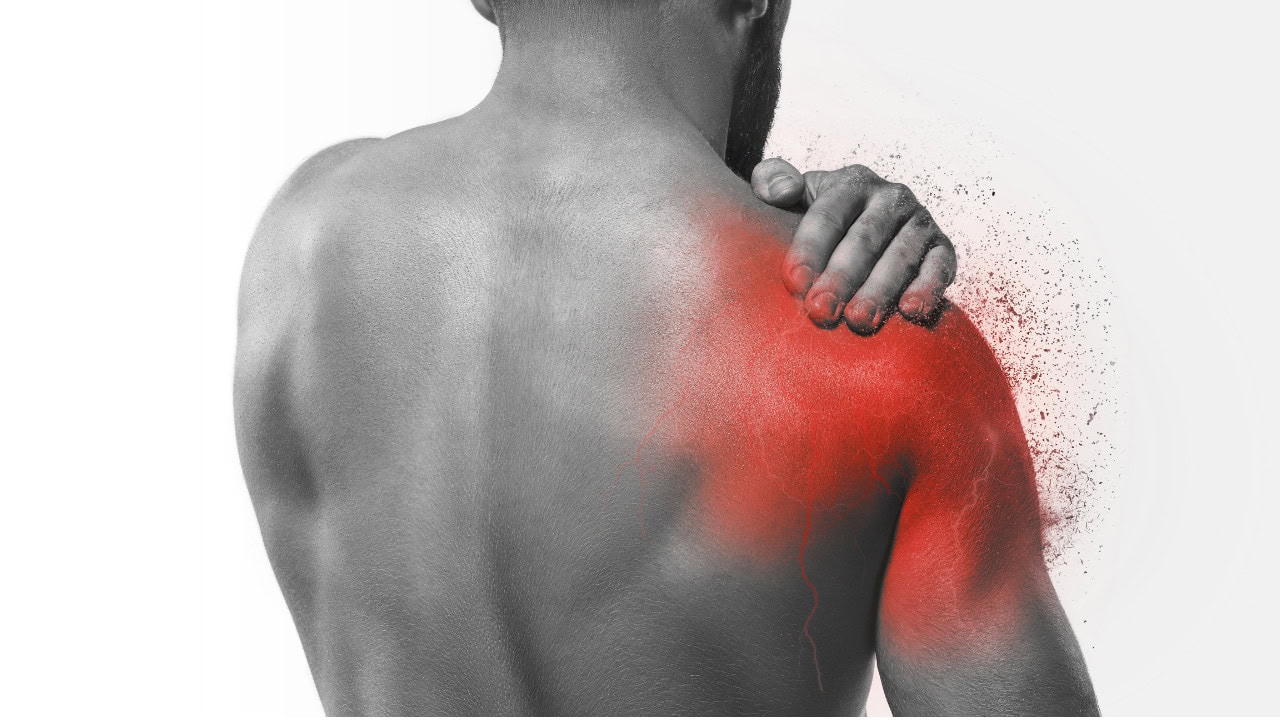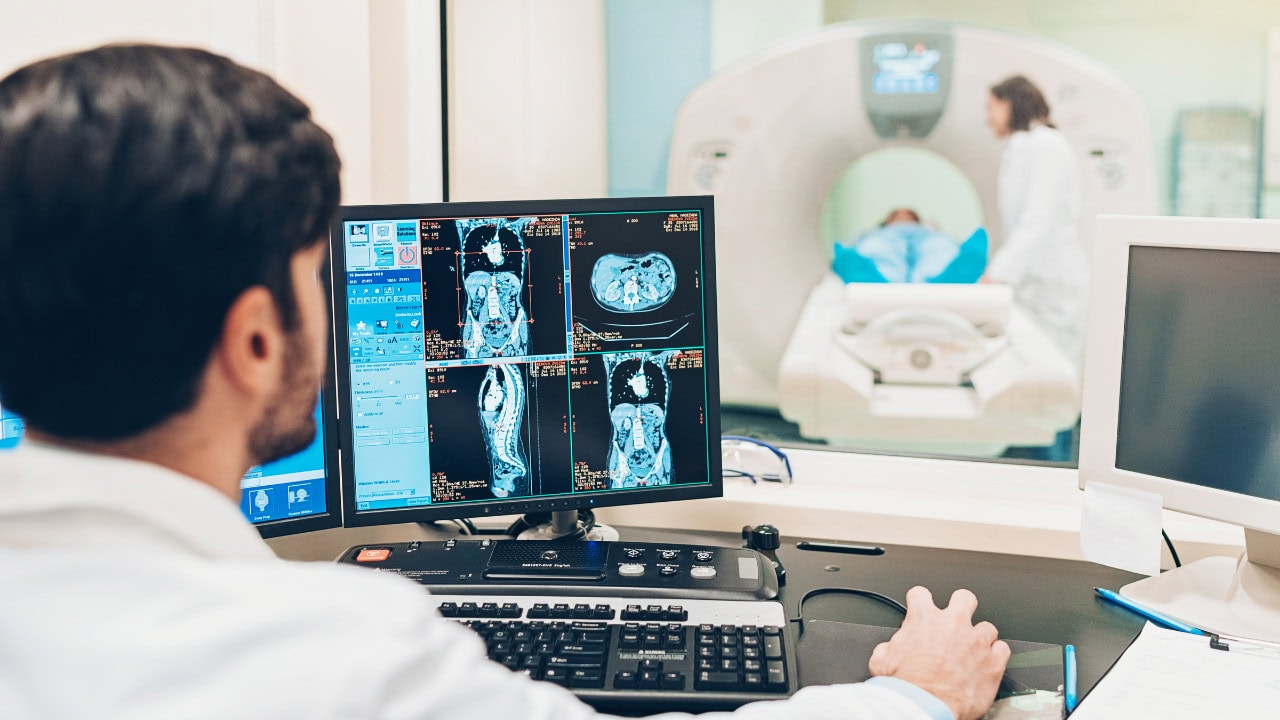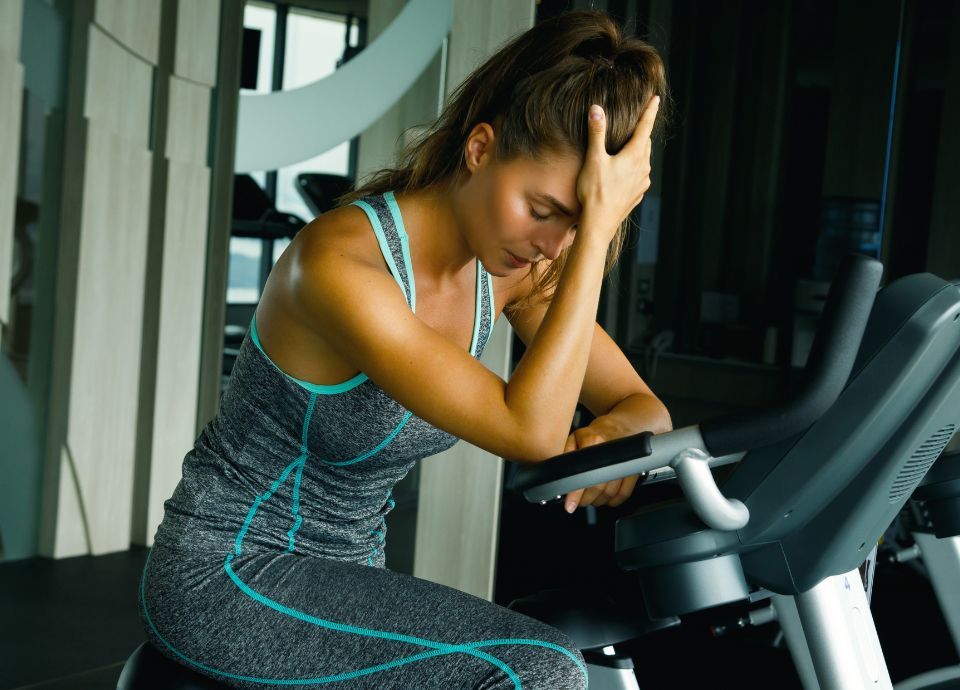Navigating Groin Pain: Dealing with Adductor Injuries in Runners and Field Athletes

Groin pain is a common overload injury seen in multidirectional athletes such as football, rugby, and hockey players. Runners are also affected, though less frequently. The incidence ranges from 5% to 18%, with runners typically on the lower end.
Managing groin pain is challenging due to the region’s complex anatomy. This includes multiple structures and the possibility of various co-existing pathologies. Therefore, understanding this anatomy is essential for diagnosis and treatment.
The pain source may originate from the lower abdomen, inguinal region, adductor muscles, hip joint, hip flexors, or perineum. Therefore, a good understanding of the anatomy of this region is crucial for both diagnosing and treating groin-related problems.

The Doha Agreement: A Clinical Framework
The Doha Consensus Statement categorizes groin pain into four primary clinical entities, based on location and symptoms:
- Adductor-related groin pain: Inner thigh pain, with tenderness and discomfort during resisted hip adduction.
- Iliopsoas-related groin pain: Pain at the front of the hip. It worsens with resisted hip flexion or stretching of the hip flexors.
- Inguinal-related groin pain: Pain in the inguinal canal area. It increases with abdominal contraction or actions that increase intra-abdominal pressure like coughing.
- Pubic-related groin pain: Pain localized to the pubic symphysis, with tenderness over the bone.
For all types, pain is localized and worsens with physical activity. This classification supports accurate diagnosis and tailored treatment.
In runners, the most common causes of groin pain stem from injuries in the adductor muscle group or the perineum area.
Key Risk Factors
Several high-level studies identify the main contributors to groin injuries:
- Previous injury: Unsurprisingly, a history of groin pain is a strong predictor of future occurrences. Hence the importance of thorough rehabilitation and addressing any residual issues after an initial injury.
- Higher level of play: Elite athletes are more prone due to training intensity and competitive load.
- Reduced hip adduction strength: Weakness in these muscles undermines pelvic stability, making injury more likely.
- Insufficient sport-specific training: A lack of tailored training and preparation for the physical demands of the sport raises injury risk.
- Male sex: Male athletes experience groin injuries more often than females.
Possible, though less significant, risk factors include:
- Older age
- Taller or heavier body types
- Position played in multidirectional sports
- Reduced hip ROM: abduction, adduction, extension, flexion, internal rotation
- Lower hip flexor strength
Pathophysiology
In runners, the most common causes of groin pain stem from problems with the adductor muscle group or the perineum area. In this article we will cover what the causes and symptoms are and how to assess and treat adductor related groin pain.
Anatomy of the Adductor Group
The adductor group consists of five muscles:
- Pectineus: Extends from the pubic bone to the femur, between the lesser trochanter and the proximal part of the linea aspera.
- Adductor Brevis: Originating from the inferior pubic ramus and inserting into the proximal part of the linea aspera of the femur.
- Adductor Longus: Arising from the anterior aspect of the pubic bone inferior to the pubic tubercle, and also attaching to the middle portion of the linea aspera.
- Adductor Magnus: The largest of the group, originating from both the inferior pubic ramus and the ischial tuberosity, and inserting into the linea aspera and the adductor tubercle of the femur.
- Gracilis: Gracilis: it extends between the pubis and the ischial ramus to the pes anserinus of the tibia.
These muscles stabilize the pelvis and enable hip adduction. Larger ones also assist in hip flexion or extension depending on the position of the femur. They are innervated by the obturator and femoral nerves (L2–L4).
Clinical Presentation: Recognizing the Symptoms
Adductor-related pain often arises from strain, tendon pathology, or both. Athletes may report a sudden injury or gradual overuse.
- Adductor tendinopathy: Typically presents with localized pain, weakness, and tenderness. Pain worsens during isometric adduction.
- Commonly involved muscle: The adductor longus is most often affected.
- Pain pattern: Usually starts mildly and worsens with ongoing training.
- Pain may: Decrease after warm-up, then return stronger after activity.
- Onset: Often insidious. Runners describe it as deep, dull, and toothache-like.
- Progression: Initially post-run, then becomes present during morning movement, eventually hindering activity.
- Radiation: Pain can spread to the inguinal region or lower abdomen.
- Acute exacerbation: In chronic cases, a sudden increase may signal an acute tear in addition to the chronic pathology.
Assessment
Screening
When assessing athletes presenting with groin pain, it is important to screen for abdominal and pelvic organ disorders, metastases in the goin or hip, avascular hip necrosis. Another crucial screening step is to rule out stress fractures of the femur and pubic ramus. These injuries can initially mimic hip or groin pain.
A key indicator to suspect a stress fracture is pain that worsens significantly during weight-bearing activities. If left unaddressed, this discomfort can progress to pain at rest, eventually forcing the athlete to discontinue training altogether. Therefore, maintaining a high index of suspicion for stress fractures is vital in your differential diagnosis for groin pain.
Physical Assessment
Look for tenderness at the adductor origin. Ask the athlete to perform resisted adduction. If pain is elicited, this could mean you’re dealing with adductor-related groin pain.
A positive finding during provocative maneuvers is the reproduction of the athlete’s familiar pain, specifically at the common adductor tendon insertion or the myotendinous junction (Serner et al, 2016). The following clinical tests may help to confirm adductor involvement:
Provocative Tests:
- Adductor Squeeze Test (0°): Athlete squeezes feet together with the knees extended while lying in supine. Positive if familiar pain is reproduced.
- Adductor Squeeze Test (90°): In supine lying and legs bent at 90°, the patient presses their knees inward against resistance.
- Outer Range Hip Adduction Test: The patient’s leg is passively, maximally abducted with the toes pointing up. Then, the patient actively pushes the leg into adduction against resistance.
Running Rehab: From Pain to Performance 2.0
Take this course and become a running rehab specialist!

Rehabilitating Adductor-Related Groin Pain
Programmes that strategically combine hip stability, pelvic and lumbar strengthening, and eccentric-biased exercises have demonstrated significant promise in improving running biomechanics and reducing pain. Here’s a phased approach to guide your clinical practice:
Phase 1: Early Rehabilitation
Goals: Manage pain, educate, and begin gentle loading.
- Patient education: Explain the condition, its timeline, prognosis, and rehab goals.
- Acute Pain relief: Use analgesics, manual therapy, and soft tissue techniques to relieve pain if necessary.
- Restore mobility: Focus on pain-free hip extension, ER, and abduction.
- Avoid aggressive passive stretching: It may worsen symptoms.
- Strategic load management: Implement careful load management strategies to prevent further irritation while allowing for tissue healing.
- Maintain fitness: Use low-impact activities like swimming or cycling to maintain cardiovascular fitness of the patient
- Start isometric loading: Begin gentle body-weight exercises for adductors.
- Initiate core work: Begin lower abdominal muscle loading.
Progression criteria:
- No pain during sleep, walking or sitting for 30 minutes
- Capacity testing: plank hold 30 sec
- 0° and 45° squeeze test with pain < 3/10
Phase 2: Building Strength and Kinetic Chain Integration
Goals: Build strength in hip flexors, abductors, adductors, and core; re-integrate the kinetic chain.
Exercises:
- Copenhagens: Isometric variation or incorporating hip adduction depending on loadability and pain levels.
- Skaters
- Side plank and variations
- Mountain climbers
- Hip flexion drills
- Deadlifts
- Nordics
- Calf raises, single legged if possible
- Crab walks
Progression criteria:
- Pain-free daily activities
- 30 mins of low-impact cardio without pain
- Plank: 60 sec (VAS < 3/10)
- Side plank: 30 sec per side (VAS < 3/10)
- Copenhagen hold: 30 sec each side (VAS < 3/10)
Phase 3: Return to Sport or Running
Focus: Restore explosive power, plyometrics, and sport-specific movement.
Exercises:
- Advanced Copenhagens (with top leg adduction)
- Explosive adductor drills
- Sumo deadlifts
- Cable knee raises with abduction resistance
- Lower ab exercises (e.g. slider pike-ups)
- Hanging leg raises with ball
- Reverse Nordics
- Cable reverse lunges (resistance on hip flexion)
- Burpees
References
Rankin, A. T., Bleakley, C. M., & Cullen, M. (2015). Hip Joint Pathology as a Leading Cause of Groin Pain in the Sporting Population: A 6-Year Review of 894 Cases. The American journal of sports medicine, 43(7), 1698–1703. https://doi.org/10.1177/0363546515582031
Serner, A., Weir, A., Tol, J. L., Thorborg, K., Roemer, F., Guermazi, A., & Hölmich, P. (2016). Can standardised clinical examination of athletes with acute groin injuries predict the presence and location of MRI findings?. British journal of sports medicine, 50(24), 1541–1547. https://doi.org/10.1136/bjsports-2016-096290
Weir, A., Brukner, P., Delahunt, E., Ekstrand, J., Griffin, D., Khan, K. M., Lovell, G., Meyers, W. C., Muschaweck, U., Orchard, J., Paajanen, H., Philippon, M., Reboul, G., Robinson, P., Schache, A. G., Schilders, E., Serner, A., Silvers, H., Thorborg, K., Tyler, T., … Hölmich, P. (2015). Doha agreement meeting on terminology and definitions in groin pain in athletes. British journal of sports medicine, 49(12), 768–774. https://doi.org/10.1136/bjsports-2015-094869

Anibal Vivanco
Physiotherapist, content creator
NEW BLOG ARTICLES IN YOUR INBOX
Subscribe now and receive a notification once the latest blog article is published.







